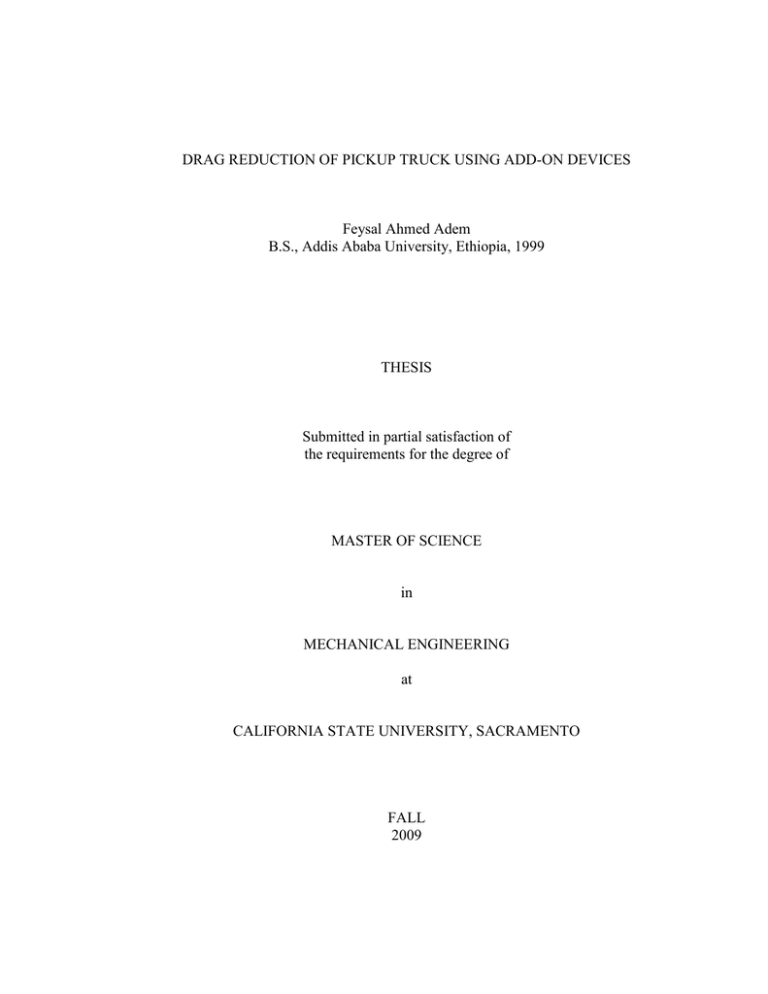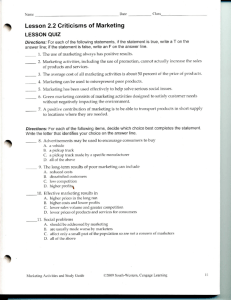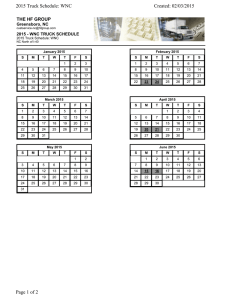
DRAG REDUCTION OF PICKUP TRUCK USING ADD-ON DEVICES
Feysal Ahmed Adem
B.S., Addis Ababa University, Ethiopia, 1999
THESIS
Submitted in partial satisfaction of
the requirements for the degree of
MASTER OF SCIENCE
in
MECHANICAL ENGINEERING
at
CALIFORNIA STATE UNIVERSITY, SACRAMENTO
FALL
2009
© 2009
Feysal Ahmed Adem
ALL RIGHTS RESERVED
ii
DRAG REDUCTION OF PICKUP TRUCK USING ADD-ON DEVICES
A Thesis
by
Feysal Ahmed Adem
Approved by:
__________________________________, Committee Chair
Dr. Dongmei Zhou
__________________________________, Second Reader
Dr. Akihiko Kumagai
____________________________
Date
iii
Student: Feysal Ahmed Adem
I certify that this student has met the requirements for format contained in the University
format manual, and that this thesis is suitable for shelving in the Library and credit is to
be awarded for the thesis.
__________________________, Graduate Coordinator
Dr. Kenneth S. Sprott
Department of Mechanical Engineering
iv
___________________
Date
Abstract
of
DRAG REDUCTION OF PICKUP TRUCK USING ADD-ON DEVICES
by
Feysal Ahmed Adem
Nowadays the reduction of drag is becoming a very important challenge for all the car
manufacturers as they are competing intensely to produce powerful pickup trucks with
better gas mileage in the market regulated with law reinforcement on fuel emissions and
consumers’ need for bigger size trucks with more horse power and cargo capacity. Lower
drag provides better performances such as higher top speed and better stability. It also
often lowers aerodynamic noise and greenhouse gas emission above all decreases in fuel
consumption. However, modern designs of pickup trucks tend to go higher and wider and
thus they have higher frontal areas due to the functional, economic and aesthetic
requirements. Increasing frontal area of the vehicle tend to increase the drag force acting
on the vehicle which is proportional to the dimensionless drag coefficient CD and the
projected area of the vehicle. Consequently, to hold or even decrease the drag on a truck
that has a larger frontal area, tremendous effort has to be made.
The purpose of this research is to design various aerodynamic add-on devices that can be
attached to the pickup truck and reduce aerodynamic drag of the vehicle without
comprising on its main design features. The research approach is using computational
v
fluid dynamics (CFD) technique. This thesis focuses on investigating the effects of addon devises such as Tonneau cover, Rear Roof Garnish, Tail plates, Airdam, Traditional
canopy, and Aerocap with 5 different rear inclination angles. After the effect of these
add-on devise was quantified, Aerocap with rear inclination angle of 12⁰, was identified
as the one that had the maximum drag reduction and it was further modified to increase
the drag reduction by using the 3D curved Aerocap. The effect that drag reduction had on
the fuel economy of the truck was also analyzed. Results from numerical simulations and
analyses indicated that the 3D curved Aerocap, modified from the Aerocap with
inclination angle α= 12°, had successfully reduced the rear width than the original one.
As a result, it had reduced the drag coefficient CD by about 19.84%. It also reduced the
lift coefficient CL by about 40.72%. At last the impact of 3D curved Aerocap on the fuel
economy of the pickup truck was analyzed over the U.S. EPA driving schedules and
conclusions were drawn.
_______________________, Committee Chair
Dr. Dongmei Zhou
_______________________
Date
vi
ACKNOWLEDGMENTS
First off, I would like to express my sincerest thanks to Dr. Dongmei Zhou for her
guidance and support in the completion of my thesis. My thesis would have never been
completed without her, I am so grateful to have had the opportunity to work under
Professor Zhou.
Secondly, I would like to thank Professor Akihiko Kumagai who spent his
precious time reviewing and making suggestions in my thesis.
Lastly, I would like to thank my family and friends for their help and support
throughout my life.
Feysal Ahmed Adem
B.S. Mechanical Engineering
July, 1999
vii
TABLE OF CONTENTS
Page
Acknowledgments...................................................................................................... vii
List of Tables…………………………………………………………………………..x
List of Figures ............................................................................................................. xi
Chapter
1. INTRODUCTION TO VEHICLE AERODYNAMICS
1.1 Introduction
………………………. 1
………………………………………………………………. 1
1.2 Flow around a Vehicle
…………………………………………………. 3
1.3 Boundary layer and separation of flow over a vehicle …………………….. 5
1.4 Aerodynamic forces on vehicles ………………………………………….. 10
1.5 Fuel economy ................................................................................................15
2. BACKGROUND AND OBJECTIVE ..................................................................22
2.1 Motivation ................................................................................................…...22
2.2 Pickup truck history …………………………………………………………23
2.3 Previously conducted research.........................................................................25
2.4 Objective..........................................................................................................26
2.5 Outlines ……………………………………………………………………...27
3. PROBLEM FORMULATION............................................................................... 28
3.1 Introduction.................................................................................................... 28
3.2 Aerodynamic drag on Vehicles. .................................................................... 29
3.3 CFD problem formulation... .......................................................................... 31
viii
3.4 Baseline Pickup truck CFD method and setup. ............................................. 34
3.5 Baseline pickup truck results and discussion................................................. 37
3.6 Summary.................................... .................................................................... 46
4. STUDY OF ADD-ON DEVICES ......................................................................... 48
4.1 Pickup truck model with Tonneau cover............................................ ........... 48
4.2 Pickup truck model with Rear Roof Garnish................................................. 55
4.3 Pickup truck model with Tail Plates....................................................... ....... 60
4.4 Pickup truck model with Airdam............................... .................................... 63
4.5 Pickup truck model with Traditional canopy..................................................68
4.6 Pickup truck model with Aerocap...................................................................71
4.7 Pickup truck model with 3D curved Aerocap................................................ 85
4.8 Impact of 3D curved Aerocap on fuel economy of pickup truck.................. 90
5. CONCLUSION AND FUTURE WORK ………………………………………. 93
5.1 Conclusions.................................................................................................... 93
5.2 Future work................................................. ................................................... 95
Appendix......................................................................................................................96
References…………………………….……………………………………………...97
ix
LIST OF TABLES
Page
1. Table 3.1 Solver setting…………………………………………………………...35
2. Table 3.2 Viscous model and Turbulence model settings………………………...35
3. Table 3.3 Boundary condition settings……………………………………………36
4. Table 3.4 Solution controls………………………………………………………..36
5. Table 4.1.1 Comparison of drag and lift coefficient of baseline pickup truck model
with a model fitted with Tonneau cover……………….……………………………..55
6. Table 4.2.1 Comparison of drag and lift coefficient of baseline pickup truck model
with a model attached with Rear Roof Garnish………………………………………59
7. Table 4.3.1 Comparison of drag and lift coefficient of baseline pickup truck with a
model attached with Tail plates………………………………………………………63
8. Table 4.4.1 Comparison of drag and lift coefficient of baseline pickup truck with a
model attached with Airdam-3in and Airdam-6in……………………………………68
9. Table 4.5.1 Comparison of drag and lift coefficient of baseline truck model with a
model attached with Traditional canopy……………………………………………..70
10. Table 4.6.1 Comparison of drag and lift coefficient of pickup truck with Aerocap at
different rear inclination angle α with the baseline truck…………………………….85
11. Table 4.7.1 Comparison of drag and lift coefficient of baseline pickup truck with
Aerocap α=12° and 3D curved Aerocap………………………………………...……90
12. Table 4.8.1 Impact of 19.83% reduction in 𝐶𝐷 A on Composite Fuel Economy using
G. Sovran [5] charts in Figure 1.12 …………………………………………………..91
x
LIST OF FIGURES
Page
1.
Figure 1.1 Typical energy uses and losses in a vehicle [9]………………………..2
2.
Figure 1.2 Flow over a cylinder at different Reynolds number [20]……………...3
3.
Figure 1.3 Streamline about passenger vehicle in the symmetry plane [8] ……….5
4.
Figure 1.4 Boundary layer velocity profiles [14]………………………………….6
5.
Figure 1.5 Areas of flow separation around a vehicle [5]………………………....8
6.
Figure 1.6 Flow separation on a bluff body (separation line perpendicular to the flow
direction) [5]…………………………………………………………………………..10
7.
Figure 1.7 Flow separation on a bluff body with oblique blunt base (separation line at
an angle to the flow direction) [5]………………………………………………….....10
8.
Figure 1.8 Aerodynamic force and moments acting on a vehicle………………..11
9.
Figure 1.9 fR versus road speed V for typical radial tires [5]……………………16
10. Figure 1.10 Typical bsfc maps for a gasoline and a diesel engine [5]…………...18
11. Figure 1.11 EPA driving cycle [5]……………………………………………….20
12. Figure 1.12 G. Sovran charts for the impact of changes in aerodynamic drag on the
fuel consumption for vehicles driving on the EPA schedules [5]………………….…21
13. Figure 2.2.1 Ford Model-TT from 1916…………………………………………23
14. Figure 2.2.2 Ford F-100 from 1951……………………………………………...24
15. Figure 2.2.3 Ford F-100 from 1966……………………………………………...24
16. Figure 2.2.4 Ford F-100 from 1997……………………………………………...25
17. Figure 2.2.5 Ford F-100 from 2008-2009………………………………………..25
xi
18. Figure 3.1 Flow past a circular cylinder: (a) laminar separation; (b) turbulent
separation; (c) theoretical and actual surface-pressure distribution, [7] ……………..31
19. Figure 3.2 Original 1/12th-scale generic pickup truck model used in [1], [2] …..33
20. Figure 3.3 1/12th scale of flow domain used in present simulation, all dimensions are
in mm………………………………………………………………………………….33
21. Figure 3.4 (a) Pressure on pickup cab (b) Pressure on pickup floor ……..……...37
22. Figure 3.5 (a) Pressure on pickup cab from [1]. (b) Pressure on pickup floor from
[1]…………………………………………………………………………………......38
23. Figure 3.6 (a) Pressure on tailgate (outside). (b) Pressure on the tailgate (outside)
from [1]……………………………………………………………………………......39
24. Figure 3.7 (a) Pressure on tailgate (inside). (b) Pressure on the tailgate (inside) from
[1]…………………………………………………………………………………......39
25. Figure 3.8 (a) u-velocity in y=0 plane (inside box). (b) u-velocity in y=0 plane
(inside box) from [1]…………...…………………………………………………......40
26. Figure 3.9 (a) u-velocity in y=0 plane (outside box). (b) u-velocity in y=0 plane
(outside box) from [1]…………………………………………………………….......41
27. Figure 3.10 (a) u-velocity for z=73mm and x=450mm (scaled down model) (b) uvelocity for z=73mm and x=450mm from [1]………………………….………….....41
28. Figure 3.11 (a) u-velocity for z=15mm and x=450mm (scaled down model) (b) uvelocity for z=15mm and x=450mm from [1]……………………………………...…42
29. Figure 3.12 Pressure distributions over the pickup………………………..…42, 67
xii
30. Figure 3.13 Wake profile for baseline truck (velocity vector on iso-velocity surface at
3m/s)……………………………………………………………………………....42, 54
31. Figure 3.14 (a) Streamline on z=73 mm (scaled down model) plane. (b) Streamline
on z=73mm plane from [1] …………………………………………………………...43
32. Figure 3.15 (a) Streamline on symmetry plane (b) Streamline on symmetry plane
from [1]……………………………………………………………………………43, 53
33. Figure 3.16 Static pressure distributions over the baseline truck and symmetry
plane………………………………………………………………………………44, 51
34. Figure 3.17 Total pressure distributions over the baseline truck and symmetry
plane………………………………………………………………...…………….44, 52
35. Figure 3.18 Streamline flow over the baseline pickup truck…………………….45
36. Figure 4.1.1 Pickup truck with Tonneau cover…………………………………..48
37. Figure 4.1.2 (a) Pressure coefficient plot in the symmetry plane for truck with
Tonneau cover (b) Pressure coefficient plot in the symmetry plane for baseline
truck…………………………………………………………………………..…..49, 65
38. Figure 4.1.3 Static pressure distribution over truck with Tonneau cover and
symmetry plane…………………………………………………………………….....50
39. Figure 4.1.4 Total pressure distribution over truck with Tonneau cover and symmetry
plane………………………………………………………………………………......51
40. Figure 4.1.5 Velocity magnitude vector over symmetry plane for pickup with
Tonneau cover………………………………………………………………………...53
xiii
41. Figure 4.1.6 Wake profile for pickup truck with Tonneau cover (velocity vector on
iso-velocity surface at 3m/s)…………………………………………………………..54
42. Figure 4.2.1 Pickup truck with attached Rear Roof Garnish…………………......55
43. Figure 4.2.2 (a) Pressure coefficient plot on the symmetry plane for flow over a
pickup truck with Rear Roof Garnish (b) Pressure coefficient plot on top and floor
surface of the base line truck in the symmetry plane………………………..………..56
44. Figure 4.2.3 Static pressure contour over the pickup with Rear Roof Garnish and
symmetry plane………………………………………………………..……………...57
45. Figure 4.2.4 Total pressure contour over the pickup with Rear Roof Garnish and
symmetry plane………………………………………………………………….……58
46. Figure 4.2.5 Velocity magnitude vector for a Pickup truck with Rear Roof Garnish
on the symmetry plane ………………………………………………………….…....59
47. Figure 4.2.6 Wake profile over a pickup truck with Rear Roof Garnish (velocity
vector on iso-velocity surface at 3m/s)………………..…………………....………....59
48. Figure 4.3.1 Pickup truck with attached Tail plates………………………...……60
49. Figure 4.3.2 Static pressure distribution over model with tail plates and symmetry
plane…………………………………………………………………………………..61
50. Figure 4.3.3 Total pressure distribution over model with tail plates and symmetry
plane………………………………………………………………………………..…61
51. Figure 4.3.4 Velocity magnitude vector on the symmetry plane for model with tail
plates……………………………………………………………………………….....62
xiv
52. Figure 4.3.5 Wake profile over pickup truck with tail plates (velocity vector on isovelocity surface at 3m/s)……………………….……………………………………...63
53. Figure 4.4.1 Pickup truck with Airdam ………………………………………....64
54. Figure 4.4.2 (a) Pressure coefficient plot over a model with Airdam (3in clearance
from the ground). (b) Pressure coefficient plot over a model with Airdam (6in clearance
from the ground) ………………………………………………………………….…65
55. Figure 4.4.3 (a) Pressure contour over pickup with Airdam (3in clearance from the
ground). (b) Pressure contour over pickup with Airdam (6in clearance from the
ground)..........................................................................................................................66
56. Figure 4.5.1 Pickup truck with traditional canopy………………………….........68
57. Figure 4.5.2 Pressure coefficient plot on symmetry plane for model with Traditional
Canopy…………………………………………………………………………...…...69
58. Figure 4.5.3 Static pressure distribution over model with Traditional
Canopy………………………………………………………………………………..69
59. Figure 4.5.4 Wake profile behind the pickup truck with traditional canopy (velocity
vector on iso-velocity surface at 3m/s)………………………………………………..70
60. Figure 4.6.1 Pickup truck model with Aerocap of a rear inclination angle
α=10°………………………………………………………………………………….71
61. Figure 4.6.2 Pressure coefficient plot in symmetry plane over model with Aerocap at
different α……………………………………………………….…………………….72
62. Figure 4.6.3 Total pressure on symmetry plane when rear inclination angle
α=5°…………………………………………………………………………………...73
xv
63. Figure 4.6.4 Total pressure on symmetry plane when rear inclination angle
α=10°…………………………………………………………………………….........73
64. Figure 4.6.5 Total pressure on symmetry plane when rear inclination angle
α=12°………………………………………………………………………………….74
65. Figure 4.6.6 Total pressure on symmetry plane when rear inclination angle
α=15°………………………………………………………………………………….74
66. Figure 4.6.7 Total pressure on symmetry plane when rear inclination angle
α=18.77°………………………………………………………………………………75
68. Figure 4.6.8 Pressure on symmetry plane when rear inclination angle
α=5°…………………………………………………………………………………...76
69. Figure 4.6.9 Pressure on symmetry plane when rear inclination angle
α=10°………………………………………………………………………………….76
70. Figure 4.6.10 Pressure on symmetry plane when rear inclination angle
α=12°………………………………………………………………………………….77
71. Figure 4.6.11 Pressure on symmetry plane when rear inclination angle
α=15°………………………………………………………………………………….77
72. Figure 4.6.12 Pressure on symmetry plane when rear inclination angle
α=18.77°………………………………………………………………………………78
73. Figure 4.6.13 Velocity magnitude path line on symmetry plane when rear inclination
angle α=5°……………………………………………………………………………..79
74. Figure 4.6.14 Velocity magnitude path line on symmetry plane when rear inclination
angle α=10°…………………………………………………………………………....79
xvi
75. Figure 4.6.15 Velocity magnitude path line on symmetry plane when rear inclination
angle α=12°…………………………………………………………………………...80
76. Figure 4.6.16 Velocity magnitude path line on symmetry plane when rear inclination
angle α=15°…………………………………………………………………………...80
77. Figure 4.6.17 Velocity magnitude path line on symmetry plane when rear inclination
angle α=18.77°………………………………………………………………………..81
78. Figure 4.6.18 Wake profile behind the pickup truck with Aerocap when rear
inclination angle α=5° (velocity vector on iso-velocity surface at 3m/s)……………..82
79. Figure 4.6.19 Wake profile behind the pickup truck with Aerocap when rear
inclination angle α=10° (velocity vector on iso-velocity surface at 3m/s)…………....82
80. Figure 4.6.20 Wake profile behind the pickup truck with Aerocap when rear
inclination angle α=12° (velocity vector on iso-velocity surface at 3m/s)……………83
81. Figure 4.6.21 Wake profile behind the pickup truck with Aerocap when rear
inclination angle α=15° (velocity vector on iso-velocity surface at 3m/s)…………....83
82. Figure 4.6.22 Wake profile behind the pickup truck with Aerocap when rear
inclination angle α=18.77° (velocity vector on iso-velocity surface at 3m/s)………...84
83. Figure 4.6.23 (a) Drag Coefficient (𝐶𝐷 ) versus rear inclination angle α. (b) Lift
Coefficient (𝐶𝐿 ) versus rear inclination angle α……………………………………....85
84. Figure 4.7.1 Shape changes to reduce drag of SUV [19]………………………...86
85. Figure 4.7.2 Pickup truck with 3D curved Aerocap……………………………..86
86. Figure 4.7.3 Pressure distribution over pickup with 3D curved Aerocap in the
symmetry plane………………………………………………………………………..87
xvii
87. Figure 4.7.4 Total pressure distribution over pickup with 3D curved Aerocap in the
symmetry plane……………………………………………………………………….88
88. Figure 4.7.5 Velocity magnitude path line on symmetry plane for flow over model
with 3D curved Aerocap…………………………………………………….………..89
89. Figure 4.7.6 Wake profile behind the pickup truck with 3D curved Aerocap (velocity
vector on iso-velocity surface at 3m/s)………………………………………………..89
xviii



